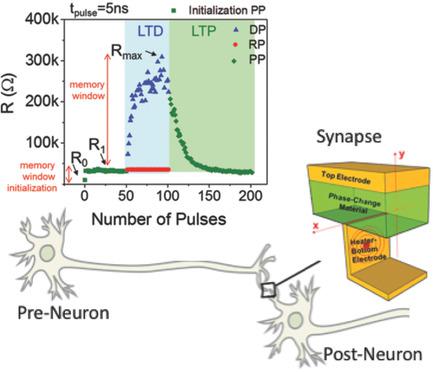当前位置:
X-MOL 学术
›
Adv. Electron. Mater.
›
论文详情
Our official English website, www.x-mol.net, welcomes your
feedback! (Note: you will need to create a separate account there.)
Narrow Heater Bottom Electrode‐Based Phase Change Memory as a Bidirectional Artificial Synapse
Advanced Electronic Materials ( IF 5.3 ) Pub Date : 2018-07-16 , DOI: 10.1002/aelm.201800223 Selina La Barbera 1 , Denys R. B. Ly 1 , Gabriele Navarro 1 , Niccolò Castellani 1 , Olga Cueto 1 , Guillaume Bourgeois 1 , Barbara De Salvo 1 , Etienne Nowak 1 , Damien Querlioz 2 , Elisa Vianello 1
Advanced Electronic Materials ( IF 5.3 ) Pub Date : 2018-07-16 , DOI: 10.1002/aelm.201800223 Selina La Barbera 1 , Denys R. B. Ly 1 , Gabriele Navarro 1 , Niccolò Castellani 1 , Olga Cueto 1 , Guillaume Bourgeois 1 , Barbara De Salvo 1 , Etienne Nowak 1 , Damien Querlioz 2 , Elisa Vianello 1
Affiliation

|
Phase change memory can provide a remarkable artificial synapse for neuromorphic systems, as it features excellent reliability and can be used as an analog memory. However, this approach is complicated by the fact that crystallization and amorphization differ radically: crystallization can be realized in a very gradual manner, very similarly to synaptic potentiation, while the amorphization process tends to be abrupt, unlike synaptic depression. Addressing this non‐biorealism of amorphization requires system‐level solutions that have considerable energy cost or limit the generality of the approach. This work demonstrates experimentally that an adaptation of the memory structure associated with an initialization electrical pulse followed by a sequence of identical fast pulses can overcome this challenge. A single device can then naturally implement gradual long‐term potentiation and depression, much like synapses in biology. This study evidences through statistical measurements the reproducibility of the approach, discusses its physical origin, as well as the importance of the device architecture and of the initial electrical pulse. Through the use of system‐level simulation, it is shown that this device is especially adapted to a neuroscience‐inspired learning. These results highlight how nanodevices can be suitable for bioinspired applications while retaining the qualities of industrial technology.
中文翻译:

基于窄加热器底部电极的相变记忆作为双向人工突触
相变存储器可以为神经形态系统提供出色的人工突触,因为它具有出色的可靠性并可以用作模拟存储器。但是,这种方法由于以下事实而变得复杂:结晶和非晶化存在根本差异:可以以非常渐进的方式实现结晶,这与突触增强作用非常相似,而与突触抑制不同,非晶化过程往往会突然发生。解决这种非生物现实的非晶化需要系统级的解决方案,这些解决方案的能源成本很高,或者限制了该方法的通用性。这项工作通过实验证明,与初始化电脉冲以及一系列相同的快速脉冲相关联的存储结构的改编可以克服这一挑战。然后,就像生物学中的突触一样,单个设备自然可以实现逐渐的长期增强和抑制。这项研究通过统计测量证明了该方法的可重复性,讨论了其物理来源,以及器件架构和初始电脉冲的重要性。通过使用系统级仿真,表明该设备特别适合于神经科学启发的学习。这些结果凸显了纳米器件在保持工业技术质量的同时,如何适合生物启发的应用。以及设备架构和初始电脉冲的重要性。通过使用系统级仿真,表明该设备特别适合于神经科学启发的学习。这些结果凸显了纳米器件在保持工业技术质量的同时,如何适合生物启发的应用。以及设备架构和初始电脉冲的重要性。通过使用系统级仿真,表明该设备特别适合于神经科学启发的学习。这些结果凸显了纳米器件在保持工业技术质量的同时,如何适合生物启发的应用。
更新日期:2018-07-16
中文翻译:

基于窄加热器底部电极的相变记忆作为双向人工突触
相变存储器可以为神经形态系统提供出色的人工突触,因为它具有出色的可靠性并可以用作模拟存储器。但是,这种方法由于以下事实而变得复杂:结晶和非晶化存在根本差异:可以以非常渐进的方式实现结晶,这与突触增强作用非常相似,而与突触抑制不同,非晶化过程往往会突然发生。解决这种非生物现实的非晶化需要系统级的解决方案,这些解决方案的能源成本很高,或者限制了该方法的通用性。这项工作通过实验证明,与初始化电脉冲以及一系列相同的快速脉冲相关联的存储结构的改编可以克服这一挑战。然后,就像生物学中的突触一样,单个设备自然可以实现逐渐的长期增强和抑制。这项研究通过统计测量证明了该方法的可重复性,讨论了其物理来源,以及器件架构和初始电脉冲的重要性。通过使用系统级仿真,表明该设备特别适合于神经科学启发的学习。这些结果凸显了纳米器件在保持工业技术质量的同时,如何适合生物启发的应用。以及设备架构和初始电脉冲的重要性。通过使用系统级仿真,表明该设备特别适合于神经科学启发的学习。这些结果凸显了纳米器件在保持工业技术质量的同时,如何适合生物启发的应用。以及设备架构和初始电脉冲的重要性。通过使用系统级仿真,表明该设备特别适合于神经科学启发的学习。这些结果凸显了纳米器件在保持工业技术质量的同时,如何适合生物启发的应用。











































 京公网安备 11010802027423号
京公网安备 11010802027423号